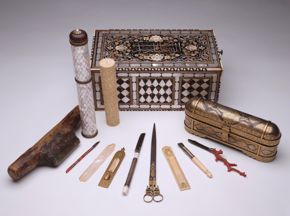Traces of the Calligrapher: Islamic Calligraphy in Practice, c. 1600–1900 November 3, 2007–February 3, 2008
Traces of the Calligrapher: Islamic Calligraphy in Practice, c. 1600–1900 maps the practice of the calligrapher from the 17th to 19th century through examples of calligraphy as well as tools of the trade. The objects in the exhibition come from Iran, Turkey, and India. Calligraphers used pens, paper, inks, and other tools. The small rectangular slab called a makta provided a surface upon which the critical act of cutting the reed pen took place; penknives shaped and gave the final clean cut to the reed pens; and inks prepared from source materials were contained in inkwells. The calligrapher prepared the paper with a burnisher to seal the surface, and cut it with scissors before proceeding to write. After the paper was inked, finishing the process included ridding the paper of excess ink by sprinkling powder from a sand shaker and using a special tool to burnish the gold. A selection of these tools illustrate the preparation of materials and the processes of writing. Craftsmen fashioned and fitted the tools with exquisite care and design, and used precious materials such as jade, agate, ivory, ebony, silver, and gold.
Calligraphic works from the same period, which were executed as practice exercises and fair copies, are displayed alongside these implements, and a video shows a master calligrapher at work. Together, the objects and their output present an overview of the intimate world and working environment of the calligrapher.
This exhibition is organized by the Museum of Fine Arts, Houston, and Harvard University Art Museums.
Generous support is provided by:
Cathy and Vahid Kooros
Oxus Energy, LLC
The Hagop Kevorkian Fund
The Kooros Family: Lily, Hamid, Shirin, and Ali
Mr. and Mrs. Ali Ebrahimi
Douglas Jaffe, III ~ Horseshoe Bay Resort
Mr. and Mrs. Pat R. Rutherford, Jr.
Mr. Kay-Ghobad “Kiddie” Zafar
Mr. Mike Hoomani
The Seaver Institute
Fariba and Rainer Buchecker
Standard Oilfield Services - Baku

